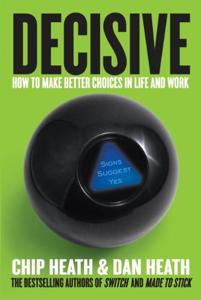
Want to learn the ideas in Decisive better than ever? Read the world’s #1 book summary of Decisive by Dan Heath, Chip,Heath here.
Read a brief 1-Page Summary or watch video summaries curated by our expert team. Note: this book guide is not affiliated with or endorsed by the publisher or author, and we always encourage you to purchase and read the full book.
Video Summaries of Decisive
We’ve scoured the Internet for the very best videos on Decisive, from high-quality videos summaries to interviews or commentary by Dan Heath, Chip,Heath.
1-Page Summary of Decisive
Overview
Many people have trouble making decisions. However, how many of those people actually try to improve their decision-making skills?
Chip and Dan Heath offer a process for making better decisions. Everyone faces difficult choices in life, whether it’s vetting job offers, deciding which car to buy or weighing whether or not to have children. By methodically correcting for natural biases and considering a wide range of options, anyone can become a better decision maker.
The human brain is efficient at processing information and forming opinions. This often serves people well, but it’s also easy to fall into the trap of relying on information that’s easy to access. A good metaphor for understanding this phenomenon is a spotlight in a theater. The audience can see only what the spotlight illuminates, but there might be other things happening on stage or behind the scenes. Good decision makers shift the spotlight, illuminating more areas and gathering more information.
People tend to make emotional and irrational decisions. There are four common errors in decision making that can be avoided by taking a step back from the situation, looking at it from different angles, collecting data that goes against your current opinion, and planning for possible outcomes.
Decision making is an art that can’t guarantee a good outcome every time. However, by identifying the most common errors and correcting for them, we can make better decisions than before.
Key Point 1: Good decision makers consider all the available options.
Often, we reduce important decisions to just two options: do something or do nothing. But that’s not always the best way to make a decision. For example, when deciding whether or not to stay in a relationship with someone, you might want more choices than “do something” and “do nothing.” Instead of those two options, you could consider ways to improve the relationship.
To expand your options, you can look for other alternatives. However, when people are focused on the problem they have, it’s hard to see other possible solutions. For example, if someone wants a new type of flooring and is thinking about wood floors or linoleum floors, he might not consider that there are many other types of floors available like ceramic tile.
Another way to increase your options is to pretend that the preferred option isn’t available. For example, a boss who wants to fire an employee will imagine firing as not being an option and then choose another action. Sometimes this new choice becomes more desirable than the original preference.
Key Point 2: Decision makers can use a process called multitracking to explore several solutions at the same time.
The strategy of exploring different options on different tracks is a good decision-making tool. This strategy can be helpful in organizational settings, such as product development. When you’re making decisions about new products, it’s better to divide into smaller groups that work separately than to have everyone working together.
When multitracking, some ideas will inevitably be discarded. However, that doesn’t mean the process is wasteful. Multitracking can often help leaders make better decisions and produce backup plans in case Option A doesn’t work out as planned.
Multitracking is a good way to depoliticize the decision-making process. Sometimes, team members become too emotionally invested in their solution and feel like they’ve failed when it’s rejected. Multitracking helps them maintain distance from the work so that they don’t take rejections personally.





